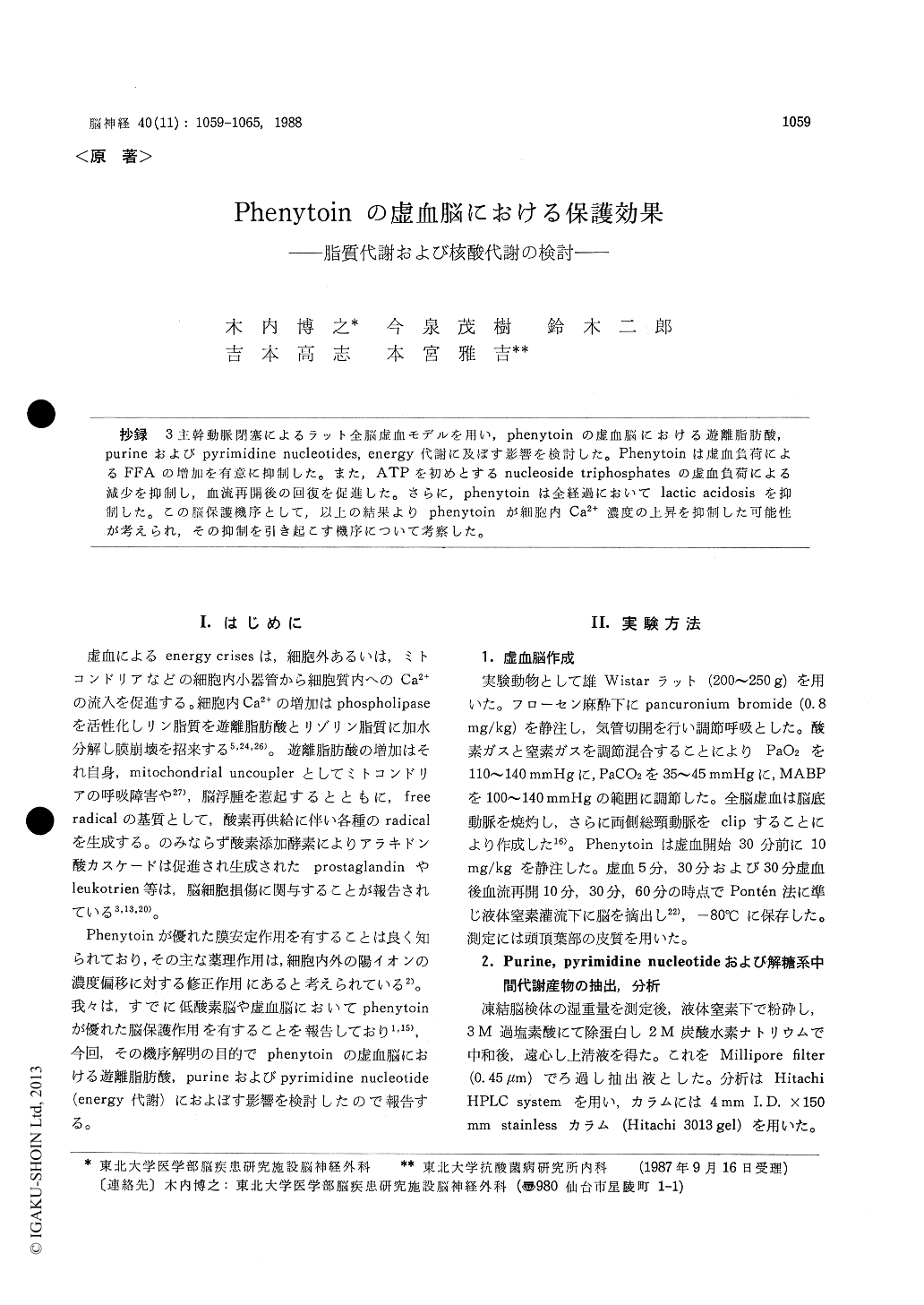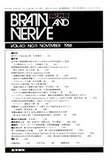Japanese
English
- 有料閲覧
- Abstract 文献概要
- 1ページ目 Look Inside
抄録 3主幹動脈閉塞によるラット全脳虚血モデルを用い,phenytoinの虚血脳における遊離脂肪酸,purineおよびpyrimidine nucleotides, energy代謝に及ぼす影響を検討した。 Phenytoinは虚血負荷によるFFAの増加を有意に抑制した。また, ATPを初めとするnucleoside triphosphatesの虚血負荷による減少を抑制し,血流再開後の回復を促進した。さらに,phenytoinは全経過においてlactic acidosisを抑制した。この脳保護機序として,以上の結果よりphenytoinが細胞内Ca2+濃度の上昇を抑制した可能性が考えられ,その抑制を引き起こす機序について考察した。
Ischemia gives rise to severe energy depletion and influx of Ca from the extracellular space, and it is suggested that increased intracellular Ca leads to the activation of phospholipase C and A, and to liberation of free fatty acids (FFA) in particular arachidonic acid. Phenytoin has been reported not only to maintain the intra-and extracellular cation balance but blockade the Ca channel.
The purpose of the present study is to investi-gate the effect of phenytoin on the liberation of FFA, energy metabolism and mononucleotide me-tabolism in ischemic brain.
Male Wistar rats were subjected to global cere-bral ischemia induced by the occlusion of basilar and bilateral common carotid arteries. The brains were frozen in situ by the funnel technique after5 or 30 min of ischemia or after 10, 30, or 60 min of recirculation following 30 min of ischemia. Purine and pyrimidine nucleoties, FFA, and gly-colytic intermediates were measured by HPLC, GLC, and fluoroenzymatic method.
In non-treated rats, ATP reached a nadir after 5 and 30 min of ischemia. Phenytoin significantly attenuated ATP depletion after 5 and 30 min of ischemia. And also E. C. is higher in phenytoin treated rats than in non-treated rats in ischemia. After 60 min of recirculation, ATP recovered to 1. 93± 0. 02 μimol (72.3% of pre-ischemia) in treated rats but 1. 60±0. 07 ,μmol/g (60% of pre-ischemia) in non treated rats. In E. C., there are significant differences between non-treated and treated rats after 10 and 30 min of recirculation.
The levels of GTP, CTP, and UTP decreased during ischemia and recovered 73. 2, 77. 1, and 79. 5% of pre-ischemia levels after 60 min of re-circulation. In phenytoin treated rats, GTP was signficantly higher than in non-treated rats at all points. CTP and UTP were higher in phenytoin treated rats than in non-treated rats after 5 min of ischemia but differences were not detected between both groups after 30 min of ischemia.
In non-treated rats, lactate increased 12. 6 ±0. 93 after 5 min of ischemia and 16. 83±1:0. 43 μmol/g after 30 min of ischemia, and after recirculation decreased toward the normal level but was still 4 times higher than the preischemia value after 60 min of recircualtion. Phenytoin attenuated the accumulation of lactate in ischemia and promoted the recovery after recirculation.
In non-treated rats, the increase of FFA was most pronounced in arachidonic acid after 5 min of ischemia and in stearic acid after 30 min of ischemia. The magnitude of the increase was, therefore, not related to the degree of unsaturation of FFA. Their levels decreased during the course of recirculation and normalized after 30 min of recirculation except saturated FFA. Phenytoin attenuated the accumulation of FFA particulary arachidonic acid during ischemia. After 30 min of recirculation, the level of total FFA was lower in phenytoin treated than non-treated rats. Since phenytoin prevents the increase of the FFA and metabolic disturbance during ischemia and promotes metabolic recovery after recircula-tion, it is suggested that the protective effect of phenytoin is due to activation of Na, K-ATPase and Na-Ca exchanging system, or blockade of Ca channel-inhibition of the rise on cytosolic Na, Ca concentration-mhibitation of phospholipase activa-tion.

Copyright © 1988, Igaku-Shoin Ltd. All rights reserved.


